
Henry Hobson Richardson was an American architect, best known for his work in a style that became known as Richardsonian Romanesque. Along with Louis Sullivan and Frank Lloyd Wright, Richardson is one of "the recognized trinity of American architecture".

The University of Minnesota Old Campus Historic District is a historic district located in Minneapolis, Minnesota. Listed in the National Register of Historic Places since 1984, it includes a number of historic buildings that were constructed during the late 1800s and early 1900s. The district represents the oldest extant section of the University of Minnesota campus.

The Converse Memorial Library – also known as Converse Memorial Building – is a historically significant building designed by noted American architect H. H. Richardson. From 1885 to 1996, it housed the Malden Public Library, which now occupies a modern building adjacent to it. The former library is located at 36 Salem Street, Malden, Massachusetts.

The Ames Free Library is a public library designed by noted American architect H. H. Richardson. It is located at 53 Main Street, Easton, Massachusetts, immediately adjacent to another Richardson building, Oakes Ames Memorial Hall.
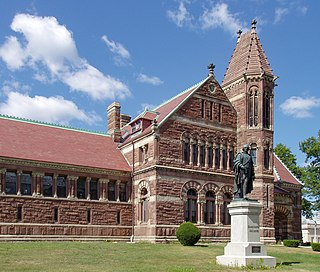
Winn Memorial Library, also known as the Woburn Public Library (1876–79) is a National Historic Landmark in Woburn, Massachusetts. Designed by architect H. H. Richardson, the Romanesque Revival building was a bequest of the Winn family. It houses the Woburn Public Library, an institution that was established in 1856.

The R. and F. Cheney Building, also known as the Brown Thomson Building, is a commercial building designed by noted American architect H. H. Richardson. It is located at 942 Main Street, Hartford, Connecticut, and is now on the National Register of Historic Places.
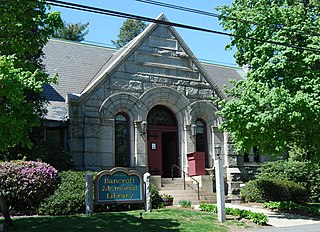
Bancroft Memorial Library is the public library serving Hopedale, Massachusetts. It is located at 50 Hopedale Street in the town center, in a fine Romanesque building built in 1898-99 and listed on the National Register of Historic Places.

The Richmond Memorial Library is located on Ross Street in Batavia, New York, United States. It is an 1880s stone structure in the Richardsonian Romanesque style designed by Rochester architect James Goold Cutler.
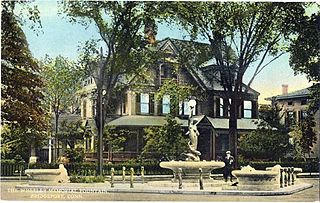
Joseph Walter Northrop (1860–1940) was an American architect.

New Milford station is a former railroad station on Railroad Street in New Milford, Connecticut. Built in 1886 by the Housatonic Railroad Company, it cemented the town's importance as a regional tourist and business center. It served passenger service until 1970, and is now home to the Greater New Milford chamber of commerce. It was listed on the National Register of Historic Places in 1984.

Greenwich YMCA is a historic building at 50 East Putnam Avenue in Greenwich, Connecticut. Built in 1916 as a gift from Mrs. Nathaniel Witherill, it is a distinctive example of Colonial Revival / Georgian Revival style with Beaux Arts flourishes. The building was listed on the U.S. National Register of Historic Places in 1996.

The U.S. Post Office-Milford Main, also known as Milford Main Post Office, is a historic post office building at 6 West River Street in Milford, Connecticut. It is a red brick building, trimmed with limestone, that was designed by James A. Wetmore and completed in 1931. It is a fine local example of Classical Revival design, making a significant contribution to a cluster of civic buildings around a triangular park north of Milford's commercial district. The building was listed on the National Register of Historic Places in 1986.

The Walker Memorial Library is the public library of Westbrook, Maine, USA. It is located at 800 Main Street, in an architecturally distinguished French Chateauesque building designed by Frederick A. Tompson and built in 1894. It was added to the National Register of Historic Places in 1980.

Warder Public Library is a historically significant building in Springfield, Ohio, United States. A robust example of Richardsonian Romanesque architecture, it was a gift to the city from industrialist Benjamin H. Warder, and served as the main branch of the Clark County Public Library from 1890 to 1989. It now houses the Clark County (Warder) Literacy Center.
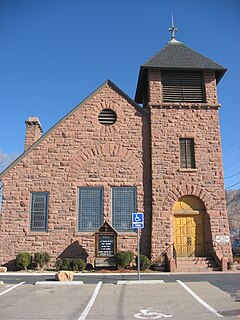
The Old Stone Congregational Church, also known as the First Congregational Church of Lyons, is a historic church in Lyons, Colorado, built in 1894-5 and listed on the National Register of Historic Places in 1976.
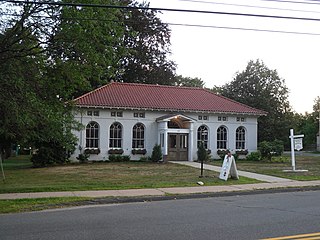
The West End Library, now the Unionville Museum, is a historic library and museum building at 15 School Street in the Unionville village of Farmington, Connecticut. The Renaissance style building was designed by New York City architect Edward Tilton, and completed in 1917 with funding from Andrew Carnegie. The building was added to the National Register of Historic Places in 2000.

The Atlanta Public Library, located at the intersection of Race and Arch Streets in Atlanta, Illinois, was built in 1908 and has operated continuously as a library since. Architect Paul A. Moratz's design combines the Neoclassical with an octagonal plan, an uncommon mixture of styles. The building's eight sides are all symmetrical except for the front, which is broken by a classical portico with Doric columns and a round arched entrance. The library is topped by a red tile roof.
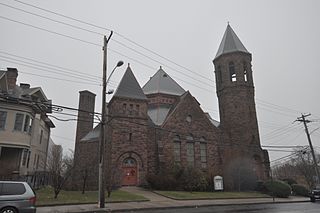
The First Baptist Church is a historic church at 126 Washington Avenue in Bridgeport, Connecticut. Built in 1893, it is a distinctive local example of Richardsonian Romanesque architecture, designed by local architect Joseph W. Northrop for a congregation founded in 1837. It was listed on the National Register of Historic Places in 1990.

The United Bank Building is a historic commercial building at 19–21 Main Street in downtown New Milford, Connecticut. Designed by Wilson Potter and built 1902–04, it is a prominent local example of Classical Revival architecture, built to house two banks whose previous buildings had been destroyed in a devastating fire. The building was listed on the National Register of Historic Places in 1982, and is a contributing element of the New Milford Center Historic District.

Memorial Hall is a historic meeting hall at South Main and Elm Streets in Windsor Locks, Connecticut. Built in 1890 as a memorial to the town's American Civil War soldiers, it has served for most of its existence has a meeting place for veterans' organizations, from the Grand Army of the Republic to the American Legion. It is also one of the town's finest examples of Romanesque architecturer, and was listed on the National Register of Historic Places in 1987.






















